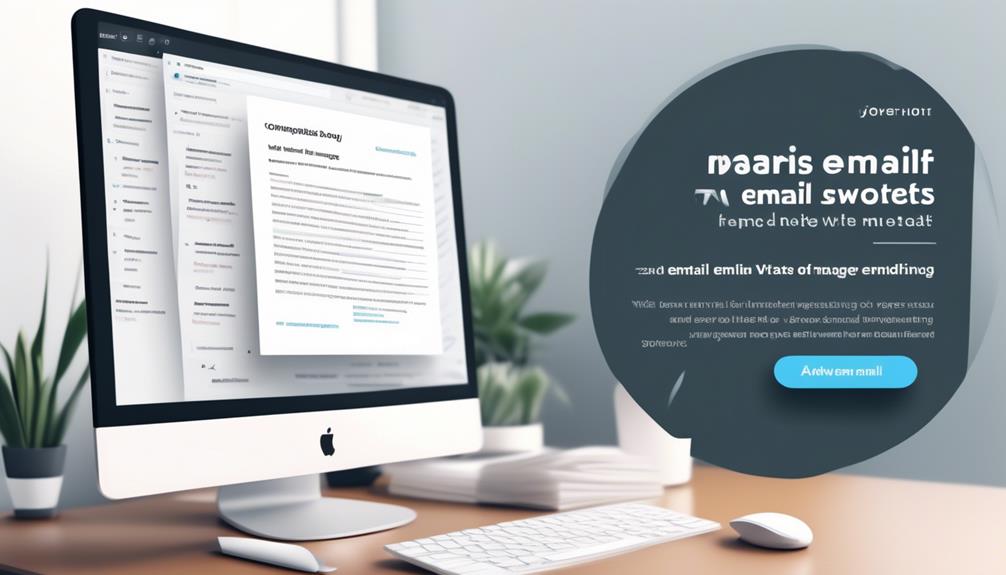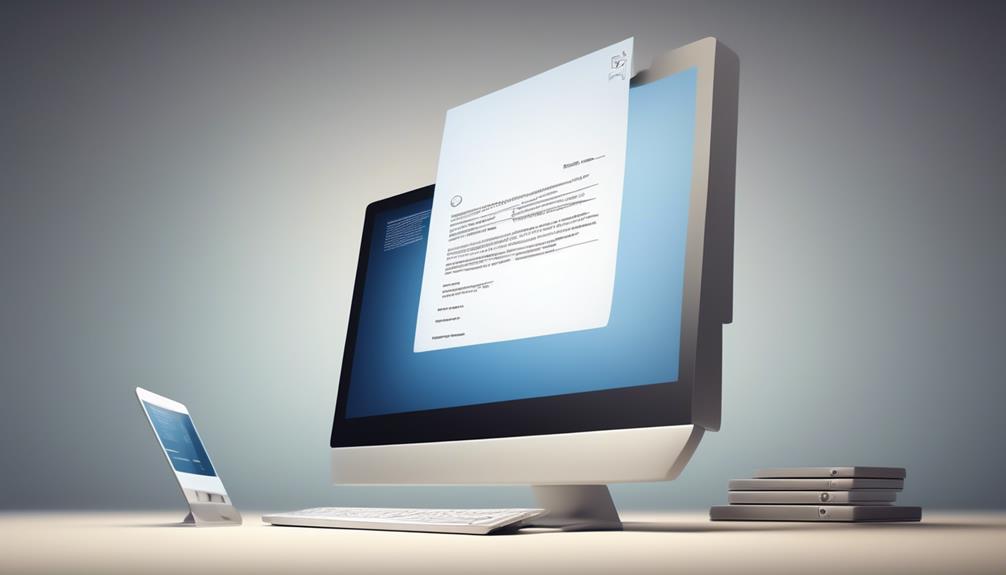Crafting an email to update our manager can feel like making our way through a labyrinth – we must identify the clearest route to share our progress and intended actions without veering off into irrelevant specifics.
We all know the feeling of sitting down to compose such an email and feeling the pressure to strike the right balance between being informative and not overwhelming our manager with information. It's a delicate dance that requires finesse and skill, and I've found a few strategies that have helped me navigate this terrain effectively.
Join me as we explore the art of crafting impactful and concise email updates that leave a lasting impression on our managers.
Key Takeaways
- Regularly sending updates to your manager is important for keeping them informed about progress and challenges.
- Email updates provide a clear understanding of completed tasks and the current status of projects.
- Timely updates allow for feedback and guidance from the manager, fostering open communication.
- Crafting a clear subject line and structuring the email body effectively help prioritize and organize the manager's inbox.
Importance of Email Updates
Regularly sending daily work updates to your manager is crucial for ensuring they're informed about your progress and any challenges you may be facing. These email updates provide your manager with a clear understanding of the tasks you have completed, the current status of your projects, and any obstacles you may be encountering. By keeping your manager in the loop through these updates, you demonstrate your proactive approach and commitment to transparency in your work.
Moreover, sending regular email updates to your manager allows them to provide timely feedback and guidance, which can help you make necessary adjustments and improvements along the way. It also helps in building trust and rapport with your manager, as they're kept informed about the ongoing developments and can offer support as needed.
Additionally, these updates serve as a record of your accomplishments and challenges, which can be valuable during performance evaluations and project reviews.
Understanding Manager's Expectations

Understanding the manager's expectations involves maintaining open communication and providing regular updates on daily work progress and project milestones. It's crucial to keep our manager informed about the progress of our tasks and any challenges we encounter.
When sending update emails, it's essential to highlight our achievements and areas for improvement in our performance reports. Additionally, conducting quarterly project reviews to discuss our accomplishments, obstacles faced, and upcoming plans with our manager demonstrates our commitment to meeting their expectations.
Furthermore, when working on special projects, seeking input and guidance from our manager and providing them with regular updates ensures that we're aligned with their expectations.
Crafting a Clear Subject Line
To effectively keep our manager informed about our progress and ensure open communication, crafting a clear subject line in our update emails is essential.
A clear subject line serves as a guide for our manager, clearly stating the purpose of the email. It should be specific, using keywords related to the content of the email to provide a quick overview of what to expect.
Conciseness is key; the subject line should be kept to the point, avoiding vagueness or generic phrases that could lead to confusion.
When crafting a clear subject line, it's important to ensure that it accurately reflects the email's contents. This helps our manager prioritize and organize their own inbox efficiently.
Structuring the Email Body

How can we effectively structure our email body to provide a clear and comprehensive project update?
When composing the email body, it's essential to begin with a warm greeting and a genuine inquiry about the recipient's well-being. This sets a positive tone and shows consideration for the manager as a person.
Next, provide a concise yet informative project update. Clearly state the project's goals, the progress made, significant accomplishments, and completed tasks. It's important to be specific and include relevant details to give the manager a clear understanding of the project's status.
Additionally, discussing any challenges encountered and the strategies implemented to overcome them demonstrates transparency and problem-solving skills. This also allows the manager to provide guidance or support if needed.
After addressing the current status, outline the next steps and clearly communicate any specific feedback or action items required from the manager.
Ending the email with a polite closing and an expression of gratitude for their time and support can leave a positive impression.
Providing Timely Updates
When updating our manager on the project, ensuring timely communication becomes pivotal in maintaining a cohesive and informed workflow. It's essential to provide regular updates on the status of the project to ensure that everyone involved is aware of the progress made and any challenges faced.
In order to achieve this, we should consider the following:
- Daily Work Updates: These should include a quick summary of accomplishments, completed tasks, and plans for the next day, allowing the manager to stay informed about our daily progress.
- Project Updates: Highlighting progress, completed tasks, challenges faced, and the project's status will provide a comprehensive overview of the project's advancement.
- Special Project Updates: Sharing progress, seeking input, keeping the manager involved, and expressing appreciation for support will ensure that the manager is informed and engaged in any special projects.
Using Professional Language

In our communication with our manager, it is crucial to maintain a professional tone and language at all times. When writing email updates to your manager, it's essential to use language that reflects respect, clarity, and professionalism. Here are some key elements to consider when composing emails to update your manager:
| Element | Description | Example |
|---|---|---|
| Formal Greeting | Address your manager with a formal salutation such as "Dear [Manager's Name]," | Dear Mr. Smith, |
| Conciseness | Keep the email concise and to the point, focusing on relevant updates and information. | "I have completed the project ahead of schedule." |
| Professional Language | Choose words and phrases that convey professionalism and respect. | "I would appreciate your feedback on the proposed strategy." |
| Respectful Request | When seeking support or feedback, maintain a respectful and courteous approach. | "I kindly request your guidance on the upcoming presentation." |
Using professional language in email writing is essential for maintaining a positive and respectful relationship with your manager. It demonstrates your professionalism and commitment to clear and effective communication. When you update your manager, using the right language can help convey your message with clarity and precision.
Incorporating Relevant Details

As we consider the importance of incorporating relevant details in our email updates to managers, it's crucial to focus on key information and pertinent updates.
By including progress made on projects or objectives and mentioning any setbacks or challenges faced, we provide a comprehensive picture of the situation.
Additionally, updates on timelines, deadlines, and any important information related to the updates help ensure that our communication is thorough and informative.
Key Information
Today, we successfully completed the tasks assigned, overcoming challenges and making significant progress on our project. Key information for the project proposal email includes:
- Milestones Achieved:
- Completed market research for the project proposal.
- Drafted a comprehensive project plan outlining timelines and deliverables.
- Secured initial buy-in from key stakeholders for the project proposal.
- Challenges Faced:
- Navigating through complex regulatory requirements for the project proposal.
- Aligning diverse team perspectives on the project proposal's scope and objectives.
- Balancing resource allocation for the project proposal amidst competing priorities.
- Next Steps:
- Refining the project proposal based on stakeholder feedback.
- Initiating discussions with potential partners for the project proposal.
- Anticipating finalization of the project proposal for review and approval.
This information will provide a comprehensive update on the project's status and progress for effective communication with stakeholders.
Pertinent Updates
After successfully completing the tasks assigned and addressing challenges, we now need to focus on providing pertinent updates incorporating relevant details for effective communication with stakeholders.
When writing your email to your manager regarding updates, it's crucial to include all relevant information that will provide a comprehensive understanding of the current status and progress of the project. This includes details such as milestones achieved, any deviations from the original plan, impact on timelines, and any potential risks or issues that may require attention.
Seeking Approval Effectively

As we continue our discussion on writing effective emails to managers regarding updates, it's crucial to address the art of seeking approval effectively.
We all strive to efficiently request and gain our manager's approval, ensuring that the process is smooth and streamlined.
It's essential to understand how to effectively seek our manager's support and guidance, which can significantly impact project progress.
Requesting Managerial Approval
To effectively seek managerial approval, it's essential to clearly outline the completed tasks, challenges encountered, and plans for tomorrow in the email update to the manager.
When writing an email requesting managerial approval, it's important to:
- Provide a concise summary of completed tasks, emphasizing their impact on the project's progress.
- Highlight any challenges faced and the strategies employed to overcome them, demonstrating resilience and problem-solving abilities.
- Clearly outline the proposed plan for the upcoming tasks, seeking the manager's input and approval to ensure alignment with the project's objectives.
Efficiently Seeking Manager's Approval
In effectively seeking managerial approval, it's crucial to succinctly summarize completed tasks, address encountered challenges, and outline upcoming plans, ensuring alignment with the project's objectives.
When writing email requests for approval, it's essential to be concise and articulate to respect the manager's time. By providing a clear and organized overview of the completed work, any obstacles faced, and the proposed next steps, the manager can efficiently assess the situation and provide timely approval.
A well-structured email that includes all necessary details without unnecessary fluff demonstrates professionalism and respect for the manager's busy schedule.
Our goal is to streamline the approval process and facilitate effective decision-making, allowing the manager to make informed decisions promptly.
Gaining Manager's Approval
Our team's progress and completed tasks require the manager's approval to ensure alignment with project objectives and facilitate timely decision-making. When seeking the manager's approval, it's crucial to approach the communication effectively.
Here are three key points to consider when gaining the manager's approval:
- Clearly outline the specific tasks or accomplishments that require approval, providing relevant context and impact on the project progress.
- Demonstrate how the approved tasks align with the overall project goals and contribute to the team's success.
- Highlight any potential challenges or risks associated with the tasks and propose mitigation strategies to address them effectively.
Highlighting Achievements

Our accomplishments and milestones in the project updates are clearly outlined, emphasizing our achievements for the month in the performance reports. When highlighting achievements in our communications with our manager, it's crucial to focus on best practices and results. By showcasing our successes, we not only demonstrate the value we bring to the team but also reinforce our commitment to delivering exceptional outcomes.
In our quarterly project review, we've the opportunity to review the progress and achievements of our project over the past few months. This presents a prime occasion to showcase the milestones we've reached and the positive impact of our contributions. Rather than merely listing tasks completed, we should emphasize the significant achievements and their alignment with the overall project objectives.
It's also important to keep our manager involved in the progress of special projects and seek their input and guidance. By proactively sharing our achievements and seeking feedback, we demonstrate our dedication to continuous improvement and our openness to leveraging their expertise to drive even greater success. This approach not only fosters a collaborative work environment but also ensures that our manager is informed and engaged in our progress.
Addressing Challenges Proactively

Demonstrating our proactive approach, we continually anticipate potential challenges and take initiative to address them before they escalate, aligning with our commitment to delivering exceptional outcomes. When addressing challenges proactively, we aim to:
- Anticipate and identify potential obstacles: By actively scanning for potential issues, we can swiftly devise strategies to overcome them.
- Implement specific action plans: We believe in taking specific, measurable actions to mitigate risks and address challenges before they escalate.
- Communicate effectively: Our proactive approach involves open communication with the manager, where we not only highlight potential obstacles but also propose well-thought-out solutions.
This proactive stance enables us to consistently maintain a smooth workflow and uphold our standard of excellence.
We ensure that our email finds you well and that you're informed about our efforts to anticipate and address challenges effectively. We're committed to taking specific actions to address potential challenges and maintain the quality of our work.
Sharing Future Plans

As we look ahead, we're eager to share our future plans, including the progress made on projects and objectives, any setbacks or challenges faced, updates on timelines and deadlines, and any important information related to these updates.
Our project team has made significant strides in meeting the outlined objectives. We've successfully completed the initial phase of the project, including thorough research and analysis. However, we did encounter some unforeseen challenges related to resource allocation, which caused a slight delay in the timeline.
Despite this setback, we've developed a mitigation plan and reallocated resources to ensure that we stay on track for the upcoming milestones. In addition, we've identified opportunities to streamline certain processes, which will ultimately contribute to improved efficiency and timeline adherence.
As we continue to move forward, we're committed to maintaining transparent and proactive communication regarding any developments that may impact the project delivery. Your guidance and support in addressing these challenges have been invaluable, and we look forward to keeping you updated on our progress.
Seeking Feedback

We value our manager's insights and expertise.
We understand the importance of seeking feedback to ensure we're on track.
Requesting input and seeking guidance from our manager and experienced coworkers will help us refine our approach and improve our work.
We aim to actively incorporate their feedback into our updates to ensure we're meeting expectations and delivering high-quality results.
Requesting Input
Seeking feedback from experienced coworkers or the manager is crucial to ensure that our updates accurately reflect the progress and address any challenges encountered. When requesting input, it's important to:
- Clearly outline the progress made on projects or objectives, demonstrating a thorough understanding of the current status.
- Discuss any setbacks or challenges encountered during the process, showing a proactive approach to problem-solving.
- Include updates on timelines, deadlines, and any important information related to the updates, ensuring that all relevant details are provided.
Seeking Input
In our pursuit of improvement, we're eager to obtain valuable feedback from the manager to enhance our job performance. Seeking input from our manager is essential for our professional growth. We're open to receiving constructive criticism and insights on our work.
Our aim is to continually refine our skills and deliver exceptional results. We believe that the manager's input will provide us with valuable guidance in navigating any challenges and optimizing our performance. Moreover, we're committed to incorporating the feedback received to enhance our productivity and effectiveness.
Additionally, we're open to engaging in interviews with practice questions to sharpen our skills and staying updated on market research to ensure our work remains relevant and impactful.
Acknowledging Manager's Response

Upon receiving the feedback from our manager, we promptly acknowledged their insightful response and expressed gratitude for their valuable guidance. We understand the importance of acknowledging the manager's response and have taken the following steps to ensure effective communication and progress:
- Confirmed Understanding: We ensured that we fully grasped the specific details provided in the manager's response, acknowledging each point and its relevance to our project.
- Progress Update: We updated the manager on the progress made based on their response, highlighting the specific areas where their input has influenced our direction.
- Request for Further Assistance: If there are any outstanding issues or uncertainties, we've clearly articulated our need for further clarification or assistance, demonstrating our commitment to addressing all concerns effectively.
Acknowledging the manager's response isn't only a sign of respect, but also a crucial step in maintaining a productive working relationship. By providing specific details in our acknowledgment, we aim to demonstrate our attentiveness and dedication to implementing the manager's guidance effectively.
Following Up on Pending Matters

We are providing an update on the progress made on our projects and objectives, including any setbacks or challenges faced.
Over the past week, our team has made significant headway on the new marketing campaign, finalizing the strategy and creative assets. However, we encountered a setback with the printing vendor, which delayed the production timeline by two days. Despite this, we've adjusted our internal deadlines to ensure minimal impact on the overall project timeline.
Additionally, the market research for the new product launch is nearing completion, with the final report expected by the end of this week.
In terms of the customer satisfaction initiative, we've successfully implemented the new feedback system and have begun analyzing the initial data.
Please let me know if there are any specific areas you'd like us to focus on in these updates.
We hope this email finds you well, and we look forward to your guidance on how to proceed with these pending matters.
Can I Use the Status Update Email Sample to Communicate with My Manager Regarding Updates?
Yes, you can use the status update email sample to communicate with your manager regarding updates. This template will help you clearly outline your progress, challenges, and next steps, ensuring that your manager is well-informed about the status of your projects.
Frequently Asked Questions
How Do You Write an Email to a Manager for an Update?
Sure, we can start by discussing the importance of communication in professional settings.
Keeping our manager informed through email updates is crucial for maintaining transparency and ensuring that everyone is on the same page. Clearly and concisely expressing our progress and any potential roadblocks helps to build trust and demonstrate accountability.
It also allows our manager to provide guidance and support as needed, ultimately contributing to the success of the team.
How Do You Write an Email for a Status Update?
We write an email for a status update by clearly stating the purpose and providing a brief overview in the opening.
Then, we organize the key information into bullet points or numbered lists for easy comprehension.
It's important to use a professional and concise tone throughout the email.
Lastly, we conclude with a clear call to action or any specific requests for the manager.
This approach ensures clarity and efficiency in communication.
How Do You Politely Ask Your Boss for an Update?
We politely ask our boss for an update by crafting a concise and respectful email.
We ensure to express our appreciation for their time and attention, then clearly and politely request the necessary information.
It's essential to maintain a professional tone and use proper email etiquette.
How Do You Write an Email to Update Information?
We understand the importance of effectively conveying updates through email.
It's crucial to craft clear, concise messages that capture attention and convey information effectively.
Our team excels at this, ensuring our emails are informative, professional, and engaging.
We prioritize clarity and brevity, allowing for efficient communication that fosters understanding and collaboration.
Conclusion
We understand the importance of clear and concise communication with our manager. By providing timely updates, sharing future plans, and seeking feedback, we can ensure that we're aligned with their expectations and working towards our goals.
Acknowledging their response and following up on pending matters shows our commitment to effective collaboration.
With a positive and appreciative tone, we can maintain a strong working relationship with our manager.









